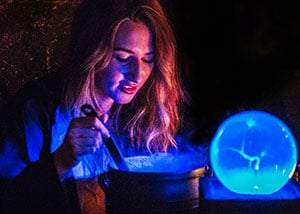NASCAR. Just the name itself is enough to typically (or stereotypically) evoke visions of men. Men gathered around a track, throwing back beer, hootin’ and hollerin.’ Men having the time of their lives as their peers thunder ridiculously fast stock cars around a track.
But true NASCAR history actually has a lot to do with some very influential women.
Here’s the ‘who’ and the ‘hows’ behind the hot rod sport we know and love today.
Sara Christian
Born in Georgia, Sara Christian was the first female NASCAR driver in history. She was married to racecar driver Frank Christian, and together they had two children. Christian’s car was named 7/11, after the ages of her two children at the time. (Now you’ll never look at a Slurpee the same way, will you?)
Her first race took place on June 19, 1949 at Charlotte Speedway. She drove her husband’s car and came in 13th place out of 33. They were the first married couple team to compete against each other. Christian also competed in the second Daytona Beach race on July 10, 1949 along with two other women, Ethel Mobley and Louise Smith. This marked the first race in NASCAR history having three women competed at the same time. Christian was named United States Driver Association Woman of the Year in 1949.
Christian had many accomplishments throughout her career. At Langhorne Speedway she finished in sixth place — a noteworthy achievement as this meant as she was the first female to finish in the top ten of a stock car racing competition.
Her final race was in Hamburg, NY. She placed 14th and proceeded to retire. Subsequently, she was made a member of the here she came in 14th place.
Sara Christian was inducted into the Georgia Automobile Hall of Fame in 2004.
Janet Gunthrie
Janet Gunthrie’s interest in NASCAR racing essentially began when she bought her first set of horsepower-hungry set of wheels — a Jaguar XK 120 Coupe. She so loved the car that it soon led to the purchase of yet another Jaguar, the XK 140. These vehicles became the catalyst for her racing career.
Gunthrie began racing in 1963, but did not commit to the sport full-time until 1972. As NASCAR history has it, after numerous years building and maintaining sports cars, she was invited by Rolla Vollstedt to test a car for the Indianapolis 500 in 1976.
A year later, in 1977, she became the first female race car driver to compete and qualify in the Indianapolis 500. Within the same year, she became the first female and top rookie to compete in the infamous Daytona 500.
Gunthrie was one of the first female athletes named in the Women’s Sports Hall of Fame. In 2006, she was also inducted into the International Motorsports Hall of Fame. Her racing suit and helmet currently hang in the Smithsonian Institute.
Ethel Mobley
Ethel Mobley’s blood was practically infused with the racing gene, and it’s even been said that her father named her after the gasoline he put in his taxi. Mobley’s love for racing was born after attending many a moonshine races with her family on Sunday afternoons. When she did dive into the driving world, Mobley was tied with Louise Smith as the second female NASCAR driver.
Mobley was part of the “Flying Flocks” — a name bestowed upon Ethel and her three siblings, Tim, Fonty and Bob. They were the first family of racecar drivers in NASCAR history to have four siblings compete in the same race, the Daytona Beach Course on July 10, 1949. This race also marked the first time for a brother(s) and sister combo to compete against one another.Tim finished second, while Ethel finished 11th — beating both Fonty and Bob in her Cadillac.
Ethel competed in over 100 races over the duration of her career, the most notable being a Florida race in which she competed against 57 men and finished in an admirable eighth place. Not bad, huh?
Louise Smith
Tied with Ethel Mobley as the second female racer in NASCAR history, Georgia-born Louise Smith was fondly known as the “First Lady of Racing.”
Smith’s racing career was initiated when she visited the Daytona Beach Road Course in 1949, simply to watch the race. Once there, she didn’t have it in her to remain a spectator. She entered the race using her family’s new Ford Coupe. Issued unlucky number 13, she unsuccessfully pleaded with every single race car driver to switch numbers with her. She tried to shake her superstitions, but later suffered the misfortune of crashing into a second car pile-up during the race, thereby perpetuating the unlucky myth behind the number 13. Ironically she finished the race in 13th place.
This race soon went down in NASCAR history for reasons entirely unrelated to numerical myth, as both Ethel Mobley and Sara Christian were competing and were noted as the first race to have three women participating.
Smith’s career spanned from 1949 to 1956. She brought home an impressive 38 wins over this time. In 1999, she again made her mark on NASCAR history and beyond, as the first woman to be inducted into the International Motorsports Hall of Fame.
Danica Patrick
Danica Patrick is one of the most famous female race car drivers in the world. Patrick was born in Wisconsin and raised in Illinois. Like most of the female drivers before her, racing was in Patrick’s blood. Her mother was a mechanic for a friend, while her father engaged in snowmobile, midget car, and motocross racing.
At 10 years old, Patrick began racing…go-karts. But when she realized the racing passion burning inside her, just waiting to be unleashed on the track, Patrick dropped out of high school, attained her GED, and at 16 years old moved to England to gain more race car driving experience. She raced in numerous UK events, including one against Jenson Button, who was then Formula One’s world champion.
In 2005, Patrick became the fourth woman to compete in the Indianapolis 500. Additionally, her performance in the 500 also marked the first time in Indy history for a woman to lead laps during a race; Patrick was at the front of the pack on three separate occasions, for a record total of leading19 laps!
Come 2008, Patrick flat-out won the Indy Japan 300, claiming the title as the first woman to ever finish first in an Indy car race. Only a few years later, in 2009, she again made history, taking third place in the Indy 500 for the highest finish ever completed by a woman in that infamous race.
Patrick’s racing career has also involved bold highlights in NASCAR history. Recently, in 2013’s Sprint Cup Series, she became the first female to claim victory over a NASCAR Sprint Cup Series pole, completing the fastest qualifying lap for the Daytona 500 since 1990.
Her crossover performance in both Indy car and stock car racing also allowed her to join ranks with Janet Gunthrie in 2012, as the only two women to have ever competed in both the Daytona 500 and the Indianapolis 500.
She was among Janet Gunthrie and Sarah Fisher and as of 2012 Patrick and Gunthrie were the only two women to have competed in both the Daytona 500 and Indianapolis 500.
Drive for Diversity Program
In 2004, NASCAR established the Drive for Diversity program, as a way to engage minorities and women in the sport. A new round of ‘non-traditional’ race car drivers is invited to participate in the program each year, encouraging interest in the sport to grow at impressive rates.
Today, the NASCAR season lasts a whopping nine months. It is the longest season of any professional sport, ranking second only to football with television ratings. With 75 million fans, it’s no secret that America craves a good round (or several) of rubber-burnin.’
And there’s no doubt that a good chunk of that 75 million includes a great number of need-for-speed girls — thanks much to NASCAR history’s decades of inspiration and influence by some fast and fearless females.
Do you have dreams of putting the pedal to the metal on a professional race track? Check out dragster, stock, exotic, Indy and Formula 2000 race car driving and ride along experiences, available at select tracks nationwide.




